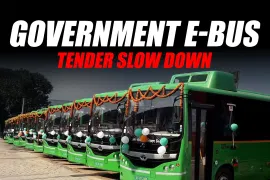By Mr. Virendra Vora, Founder and Chairman, Eco Fuel
The mobility landscape is undergoing a decisive transformation. Amid fluctuating global oil prices, tightening emission norms, and a growing urgency to decarbonize, Compressed Natural Gas (CNG) is quietly but steadily carving out a strong presence as a mainstream fuel option.
From being primarily seen as a commercial fleet fuel, CNG is now powering private vehicles across urban and semi-urban India. In FY2025, India’s CNG vehicle sales approached the one-million mark. This growth, however, hasn’t come without resistance, much of it rooted in outdated perceptions and myths that no longer hold in today’s evolved automotive and energy ecosystem.
As we work towards a more sustainable and cost-efficient future, it is essential to address these myths with facts and data.
MYTH 1: CNG Damages the Engine Over Time
Fact: Contrary to popular belief, CNG is a cleaner fuel that combusts more efficiently than petrol or diesel. It leaves fewer carbon deposits, thereby reducing engine abrasion and prolonging engine life. With regular maintenance, CNG cars can perform just as well and last just as long as conventional fuel vehicles.
MYTH 2: Safety Is a Concern with CNG Vehicles
Fact: Today’s CNG vehicles meet AIS-028 automotive safety standards, which include stringent checks, pressure-relief valves, and robust cylinder construction. Additionally, CNG’s physical properties—it is lighter than air and disperses quickly—further mitigate fire risk in the unlikely event of a leak.
MYTH 3: CNG Compromises Driving Performance
Fact: Early-generation retrofits did lead to noticeable performance drops. However, modern sequential injection systems, offer smooth acceleration, consistent power delivery, and a seamless fuel switch. For urban driving conditions—which make up the bulk of Indian road usage—CNG performance is comparable to petrol vehicles.
Myth 4: CNG Cylinders Take Up Too Much Boot Space
Fact: Manufacturers are now integrating twin-cylinder, making better use of space without compromising utility. This development ensures CNG vehicles are just as suitable for family usage, long-distance travel, and daily commutes as their petrol or diesel counterparts.
MYTH 5: Refuelling Remains Inconvenient
Fact: India’s CNG infrastructure has expanded significantly, with over 8,000 filling stations operational today, compared to just 700 a decade ago. The government’s target of 17,500 stations by 2030 is already driving infrastructure growth in Tier 1 and Tier 2 cities. Moreover, digital tools and apps have made station discovery, queue tracking, and route planning much easier.
MYTH 6: Switching Between Fuels Can Harm the Engine
Fact: Dual-fuel systems in modern CNG vehicles are designed to switch automatically between petrol and CNG based on optimal temperature and fuel levels. This enhances operational flexibility, extends engine health, and provides drivers with uninterrupted service, especially in regions with patchy CNG availability.
MYTH 7: CNG Doesn’t Offer Meaningful Cost Savings
Fact: With petrol costs exceeding ₹100 per litre in most states, CNG continues to offer substantial operational savings. On average, CNG costs ₹3–₹4 per km versus ₹6–₹7 for petrol. A commuter covering 1,000 km monthly can save ₹3,000–₹4,000, often recovering the upfront cost of the CNG system within 12–18 months.
MYTH 8: CNG Is Not Truly Green
Fact: CNG emits 25% less CO₂ than petrol and nearly 90% less particulate matter than diesel. It also contains no lead, benzene, or sulphur, making it one of the cleanest fossil-based fuels currently available. For India, which is actively pushing for cleaner air and reduced vehicular emissions, CNG is a practical bridge toward greener transport.
Conclusion: Time to Reposition CNG as a Mainstream Fuel
With rising demand, expanding infrastructure, policy support, and technological maturity, CNG today offers a compelling combination of cost-efficiency, safety, and sustainability. It is not merely an interim alternative or a low-cost backup—it is a viable long-term mobility solution that aligns with India’s goals of energy security and environmental stewardship.
As the founder of a company working at the intersection of clean mobility and public adoption, I have seen firsthand how perspectives shift when consumers are given facts, access, and reliable performance. The narrative around CNG is evolving—and so should our mindset.










